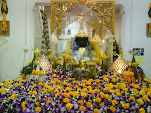本文引用地址:http://www.udnbkk.com/article/2008/1017/article_43593.html
连寺庙的香油钱都偷,就算是有千万个苦衷,佛祖愿意原谅你,香客们也肯听没有办法接受你的任何理由。
Whatever that is written here is not intended to harm or hurt anybody.Either ways, I bear no responsibilities for any physical or emotional harm to anybody or organisation.

Somdet Luang Poo Tuad Yieb Nam Thale Jued — the Exalted One
(The description ‘Yieb Nam Thale Jued’ refers to the miraculous moment when Luang Poh Tuad ‘stepped on sea water’ and in doing so ‘turned sea water into freshwater’. )
Wat Huay Mongkhon, a Buddhist monastery, houses a sculpture of Somdet Luang Poo Tuad. It is said to be the world’s largest of sculpture of His Reverend Luang Poh Tuad.
Wat Huay Mongkon (Huay Mongkon Monastery)胡

Wat Chin Pracha Samosorn, or Wat Leng Hok Yee, chinese Mahayana Buddhist temple situated on Suphakit Rd, near Ban Mai Market. It was built during the reign of King Rama V by the Chinese abbot of Wat Leng Noei Yi over a century ago.
Leng Noei Yi temple is always busy and you seldom get the chance to pray. The highlight of the temple is a set of three principle Buddha images made from paper. They are Phra Yoo Lai、Phra Onitohud,Phra Lasuhud.The images were created in China and originally meant for Leng Noei Yi.
There are preserved remains of two former abbots covered in golden leaf. They sit in the posture of meditation. Visitors never hesitate to ask for success in commerce or business from the God of Luck, which is said to bring good fortune to those who carry it in pouch hanging from the side. You have to squeeze the pouch at the bottom three times to drive your luck out of the bag, then touch your wallet to make sure your luck gets there.
A huge sacred bell is inscribed with prayers in Chinese characters all over it. There are only three of its kind in the world and built especially for illiterate people. They can just ring the bell then they can pray for their wish.
There is a statue of Guan In Bhotisattra, the God of Healing, and other Chinese deities in the temple.
Many sacred items in the temple mirror the strong faith of Chinese people in Buddhism.
沿着TaladBanMai市场走出去,路旁有很多绽放的莲花。越过一条马路,就可以看见了。这个寺院感觉很"华人",寺院的主院供奉了3尊中国艺术风格的佛像,分别名 为Phra Yoo Lai、Phra Onitohud和Phra Lasuhud,泰国人都相信3尊佛像可以保佑他们远离疾病。令人感到惊讶的是,这3尊佛像是由纸制成的,远从中国上海运至而来。
旁院里,有随着3尊佛像一起运来的18铜人尊像。虽然是黑压压的铜像,可是每一尊都栩栩如生,五官轮廓非常突出,感觉像是圣人的真身就出现在眼前似的。而这些佛像都见证了在古代泰国王朝与中国的友好邦交。
Phanthai Norasing is a symbol of integrity and honesty and his virtues are taught to all students.
Norasing lived during the Ayutthaya period about two hundred years ago. He used to be a coxswain on one of the barges of Phra Chao Sua, the King at the time. In 1704 A.D., the King was travelling along the curved Khok Kham Canal on the Ekkachai Royal Barge. There were so many bends in the canal that poor Norasing was having trouble controlling the rudder. This caused the prow of the boat to be broken off when it hit the trunk of a tree. Norasing knew very well the palace law of the time and although the King forgave him, he begged the King to have him executed.
After his death, the King built a shrine on Khok Kham Canal and commanded to have a new canal, later to be named Klong Mahachai, to be dug in a straight line in order to make a safer passage.
# One-third were converted by relatives and another third by friends and colleagues
# 35% became Buddhists to seek purpose and meaning in life
# 74% would marry someone of a different religion
# 27% expect their children to follow their religion
